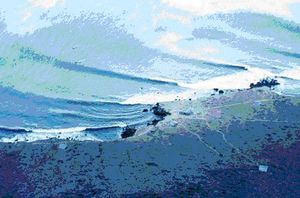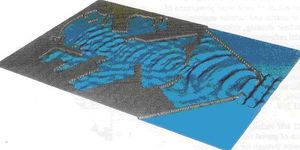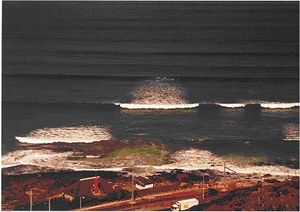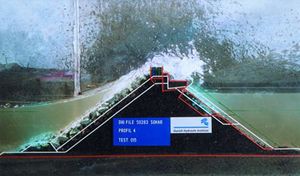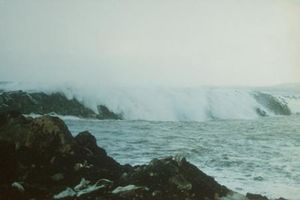Difference between revisions of "Wave transformation"
(→Depth-induced wave-breaking) |
Dronkers J (talk | contribs) |
||
| (29 intermediate revisions by 4 users not shown) | |||
| Line 1: | Line 1: | ||
| − | The following types of transformation are mainly related to wave phenomena occurring in the natural environment. When the waves approach the shoreline, they are affected by the seabed through processes such as refraction, shoaling, bottom friction and wave-breaking. However, wave-breaking also occurs in deep water when the waves are too steep. If the waves meet major structures or abrupt changes in the coastline, they will be transformed by diffraction. If waves meet a submerged reef or structure, they will overtop the reef. These phenomena will be further explained in the following. | + | The following types of transformation are mainly related to wave phenomena occurring in the natural environment. When the waves approach the shoreline, they are affected by the seabed through processes such as refraction, shoaling, bottom friction and wave-breaking. However, wave-breaking also occurs in [[deep water]] when the waves are too steep. If the waves meet major structures or abrupt changes in the coastline, they will be transformed by diffraction. If waves meet a submerged reef or structure, they will overtop the reef. These phenomena will be further explained in the following. |
| − | The following types of wave transformation occur mainly in connection with ports and the like. If the waves meet a steep structure, reflection will take place, and if the waves meet a permeable structure, partial transmission will take place. | + | The following types of wave transformation occur mainly in connection with ports and the like. If the waves meet a steep structure, reflection will take place, and if the waves meet a permeable structure, partial transmission will take place. |
| + | |||
| + | |||
| + | For a more detailed treatment of wave transformation in the nearshore the reader should consult [[Shallow-water wave theory]], [[Breaker index]] and [[Swash zone dynamics]]. | ||
| + | |||
| Line 6: | Line 10: | ||
The following is a summary of the transformation types to be found in nature. | The following is a summary of the transformation types to be found in nature. | ||
| − | === | + | ===Refraction=== |
| − | [[Image:refraction.jpg|thumb|Fig 1. Wave refraction (and breaking).]] | + | [[Image:refraction.jpg|thumb|right|Fig 1. Wave refraction (and breaking).]] |
| − | Depth-refraction is the turning of the direction of wave propagation when the wave fronts travel at an angle with the depth contours at shallow water. The refraction is caused by the fact that the waves propagate more slowly in shallow water than in deep water. A consequence of this is that the wave fronts tend to become aligned with the depth contours. [[Currents]] can also result in refraction | + | Depth-refraction is the turning of the direction of wave propagation when the wave fronts travel at an angle with the depth contours at shallow water. The refraction is caused by the fact that the waves propagate more slowly in shallow water than in [[deep water]]. A consequence of this is that the wave fronts tend to become aligned with the depth contours. [[Currents]] can also result in refraction and this is termed [[current refraction]]. |
| + | [[image:diffraction.jpg|right|thumb|Fig. 2. Wave diffraction in a port (from a numerical simulation with a short wave model).]] | ||
===Diffraction=== | ===Diffraction=== | ||
Diffraction can be seen when there are sheltering structures such as breakwaters. Diffraction is the process by which the waves propagate into the lee zone behind the structures by energy transmittance laterally along the wave crests. | Diffraction can be seen when there are sheltering structures such as breakwaters. Diffraction is the process by which the waves propagate into the lee zone behind the structures by energy transmittance laterally along the wave crests. | ||
| − | |||
| − | |||
| + | [[image:shoaling.jpg|right|thumb|Fig. 3. Shoaling]] | ||
===Shoaling=== | ===Shoaling=== | ||
| − | + | Shoaling is the deformation of the waves, which starts when the water depth becomes less than about half the [[wavelength]]. The shoaling causes a reduction in the wave propagation velocity as well as shortening and steeping of the waves. | |
| − | Shoaling is the deformation of the waves, which starts when the water depth becomes less than about half the wavelength. The shoaling causes a reduction in the wave propagation velocity as well as shortening and steeping of the waves. | ||
===Bottom friction=== | ===Bottom friction=== | ||
| Line 25: | Line 28: | ||
Depth-induced wave-breaking of individual waves starts when the wave height becomes greater than a certain fraction of the water depth. As a rule of thumb, the wave height of an individual wave at breaking is often said to be around 80% of the water depth, but this is a very approximate figure. Breaking waves are generally divided into three main types, depending on the steepness of the waves and the slope of the shoreface: | Depth-induced wave-breaking of individual waves starts when the wave height becomes greater than a certain fraction of the water depth. As a rule of thumb, the wave height of an individual wave at breaking is often said to be around 80% of the water depth, but this is a very approximate figure. Breaking waves are generally divided into three main types, depending on the steepness of the waves and the slope of the shoreface: | ||
| − | *Spilling takes place when steep waves propagate over flat shorefaces. Spilling breaking is a gradual breaking which takes place as a foam bore on the front topside of the wave over a distance of 6– 7 | + | *Spilling takes place when steep waves propagate over flat shorefaces. Spilling breaking is a gradual breaking which takes place as a foam bore on the front topside of the wave over a distance of 6– 7 [[wavelength]]s. |
*Plunging is the form of breaking where the upper part of the wave breaks over its own lower part in one big splash whereby most of the energy is lost. This form of breaking takes place in cases of moderately steep waves on moderately sloping shorefaces. | *Plunging is the form of breaking where the upper part of the wave breaks over its own lower part in one big splash whereby most of the energy is lost. This form of breaking takes place in cases of moderately steep waves on moderately sloping shorefaces. | ||
| Line 31: | Line 34: | ||
*Surging is when the lower part of the wave surges up on the foreshore in which case there is hardly any surf-zone. This form of breaking takes place when relatively long waves (swell) meet steep shorefaces. | *Surging is when the lower part of the wave surges up on the foreshore in which case there is hardly any surf-zone. This form of breaking takes place when relatively long waves (swell) meet steep shorefaces. | ||
| − | [[Image:depth induced.jpg| | + | [[Image:depth induced.jpg|thumb|500px|center|Fig. 4. Depth-induced wave-breaking: spilling, plunging and surging.]] |
| − | : | + | |
| + | [[image:irregular storm_b.jpg|thumb|right|Fig. 5. White capping can be seen on these irregular directional storm waves]] | ||
| + | [[Image:overtopping flume.jpg|thumb|right|Fig. 6. Wave-overtopping of breakwater in a flume test.]] | ||
| + | [[Image:overtopping nature.jpg|thumb|right|Fig. 7. Wave-overtopping of breakwater in nature.]] | ||
===Wave set-up=== | ===Wave set-up=== | ||
| Line 40: | Line 46: | ||
Wave swash or Wave uprush is the propagation of the waves onto the beach slope. The swash consists of an onshore phase with decelerating upwards flow (uprush or swash) and an offshore phase with accelerating downwards flow (downrush or backwash) | Wave swash or Wave uprush is the propagation of the waves onto the beach slope. The swash consists of an onshore phase with decelerating upwards flow (uprush or swash) and an offshore phase with accelerating downwards flow (downrush or backwash) | ||
| − | ===Wave run=== | + | ===Wave run-up=== |
| − | Wave run-up is the sum of the wave set-up and the wave swash. The wave run-up is this the maximum level the waves reach on the beach relative to the still water level. The run-up height exceeded by 2% of the run-up events is denoted | + | Wave run-up is the sum of the wave set-up and the wave swash. The wave run-up is this the maximum level the waves reach on the beach relative to the still water level. The run-up height exceeded by 2% of the run-up events is denoted <math>R_{2\%}</math>. Relationships for estimating <math>R_{2\%}</math> are given in [[Swash zone dynamics]]. For typical storm waves this gives: <math>R_{2\%} \approx 6 H_0 \tan \beta </math>. Here is <math>\tan \beta</math> the beach slope, and <math>H_0</math> and <math>T</math> are the significant wave height and period at deep water. |
===White-capping=== | ===White-capping=== | ||
| − | + | White-capping or top-breaking is steepness-induced wave-breaking, which occurs in deeper water when the wave height becomes too large compared to the [[wavelength]]. (see Fig. 5.) | |
| − | White-capping or top-breaking is steepness-induced wave-breaking, which occurs in deeper water when the wave height becomes too large compared to the wavelength. | ||
| − | |||
===Wave overtopping=== | ===Wave overtopping=== | ||
| − | + | Wave-overtopping takes place when waves meet a submerged reef or structure, but also when waves meet an emerged reef or structure lower than the approximate wave height. During over-topping, two processes important to the coastal processes take place: wave transmission and the passing of water over the structure. (see Fig. 6.) | |
| − | + | ||
| − | Wave-overtopping takes place when waves meet a submerged reef or structure, but also when waves meet an emerged reef or structure lower than the approximate wave height. During over-topping, two processes important to the coastal processes take place: wave transmission and the passing of water over the structure. | + | |
| + | ==Related articles== | ||
| + | :[[Shallow-water wave theory]] | ||
| + | :[[Breaker index]] | ||
| + | :[[Swash zone dynamics]] | ||
| + | :[[Waves]] | ||
| + | |||
| Line 57: | Line 67: | ||
<references/> | <references/> | ||
| − | == | + | ==Further reading== |
| + | Mangor, K., Drønen, N. K., Kaergaard, K.H. and Kristensen, N.E. 2017. Shoreline management guidelines. DHI https://www.dhigroup.com/marine-water/ebook-shoreline-management-guidelines. | ||
| + | |||
| + | |||
| + | {{author | ||
| + | |AuthorID=13331 | ||
| + | |AuthorFullName=Mangor, Karsten | ||
| + | |AuthorName=Karsten}} | ||
| − | + | [[Category:Physical coastal and marine processes]] | |
| − | + | [[Category:Beaches]] | |
| + | [[Category:Hydrodynamics]] | ||
Latest revision as of 12:44, 22 February 2024
The following types of transformation are mainly related to wave phenomena occurring in the natural environment. When the waves approach the shoreline, they are affected by the seabed through processes such as refraction, shoaling, bottom friction and wave-breaking. However, wave-breaking also occurs in deep water when the waves are too steep. If the waves meet major structures or abrupt changes in the coastline, they will be transformed by diffraction. If waves meet a submerged reef or structure, they will overtop the reef. These phenomena will be further explained in the following. The following types of wave transformation occur mainly in connection with ports and the like. If the waves meet a steep structure, reflection will take place, and if the waves meet a permeable structure, partial transmission will take place.
For a more detailed treatment of wave transformation in the nearshore the reader should consult Shallow-water wave theory, Breaker index and Swash zone dynamics.
Contents
Summary of transformation types
The following is a summary of the transformation types to be found in nature.
Refraction
Depth-refraction is the turning of the direction of wave propagation when the wave fronts travel at an angle with the depth contours at shallow water. The refraction is caused by the fact that the waves propagate more slowly in shallow water than in deep water. A consequence of this is that the wave fronts tend to become aligned with the depth contours. Currents can also result in refraction and this is termed current refraction.
Diffraction
Diffraction can be seen when there are sheltering structures such as breakwaters. Diffraction is the process by which the waves propagate into the lee zone behind the structures by energy transmittance laterally along the wave crests.
Shoaling
Shoaling is the deformation of the waves, which starts when the water depth becomes less than about half the wavelength. The shoaling causes a reduction in the wave propagation velocity as well as shortening and steeping of the waves.
Bottom friction
Bottom friction causes energy dissipation and thereby wave height reduction as the water depth becomes more and more shallow. Friction is of special importance over large areas with shallow water.
Depth-induced wave-breaking
Depth-induced wave-breaking of individual waves starts when the wave height becomes greater than a certain fraction of the water depth. As a rule of thumb, the wave height of an individual wave at breaking is often said to be around 80% of the water depth, but this is a very approximate figure. Breaking waves are generally divided into three main types, depending on the steepness of the waves and the slope of the shoreface:
- Spilling takes place when steep waves propagate over flat shorefaces. Spilling breaking is a gradual breaking which takes place as a foam bore on the front topside of the wave over a distance of 6– 7 wavelengths.
- Plunging is the form of breaking where the upper part of the wave breaks over its own lower part in one big splash whereby most of the energy is lost. This form of breaking takes place in cases of moderately steep waves on moderately sloping shorefaces.
- Surging is when the lower part of the wave surges up on the foreshore in which case there is hardly any surf-zone. This form of breaking takes place when relatively long waves (swell) meet steep shorefaces.
Wave set-up
Wave set-up is a very important phenomenon in the surf-zone hydrodynamics. This is a local elevation in the mean water level on the foreshore, caused by the reduction in wave height through the surf-zone. The wave set-up is proportional to the wave height at breaking. As a rule of thumb, the wave set-up is 20% of the offshore significant wave height. Gradients in wave set-up, e.g. in partly sheltered areas near port entrances, will generate local circulation in the surf-zone towards the sheltered area.
Wave swash
Wave swash or Wave uprush is the propagation of the waves onto the beach slope. The swash consists of an onshore phase with decelerating upwards flow (uprush or swash) and an offshore phase with accelerating downwards flow (downrush or backwash)
Wave run-up
Wave run-up is the sum of the wave set-up and the wave swash. The wave run-up is this the maximum level the waves reach on the beach relative to the still water level. The run-up height exceeded by 2% of the run-up events is denoted [math]R_{2\%}[/math]. Relationships for estimating [math]R_{2\%}[/math] are given in Swash zone dynamics. For typical storm waves this gives: [math]R_{2\%} \approx 6 H_0 \tan \beta [/math]. Here is [math]\tan \beta[/math] the beach slope, and [math]H_0[/math] and [math]T[/math] are the significant wave height and period at deep water.
White-capping
White-capping or top-breaking is steepness-induced wave-breaking, which occurs in deeper water when the wave height becomes too large compared to the wavelength. (see Fig. 5.)
Wave overtopping
Wave-overtopping takes place when waves meet a submerged reef or structure, but also when waves meet an emerged reef or structure lower than the approximate wave height. During over-topping, two processes important to the coastal processes take place: wave transmission and the passing of water over the structure. (see Fig. 6.)
Related articles
References
Further reading
Mangor, K., Drønen, N. K., Kaergaard, K.H. and Kristensen, N.E. 2017. Shoreline management guidelines. DHI https://www.dhigroup.com/marine-water/ebook-shoreline-management-guidelines.
Please note that others may also have edited the contents of this article.
|
